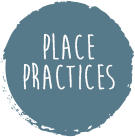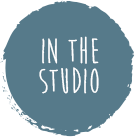

1. Working with gesture
In this clip Margaret uses a gesture that Adrian offered in the car on the way to rehearsal and asks the company to develop it. Often Adrian offers material during the journey ready to use in the rehearsal. She reminds him that he was very careful with the gesture. She transposes the material from one body to many and expands it in time and space. The company then take this work to the site and continue to develop it outside the chapel doors. Placing the work on site shifts how we read it, bringing additional meaning to both the place and the gesture. The place is performed and meaning invoked through the positioning of the gesture within it.
3. Creating Choreographic Material
In this clip Adrian is seen creating material. Margaret asks Adrian if he wants the performers to be standing up or sitting down and he says ‘down on the floor’. She asks Adrian if he is ready to do something and he nods yes. Margaret asks Adrian to begin work. He says it is not him who is doing the work and she tells him that it is him. She asks what he is doing as he begins, sees he is at work and asks the company to follow. This is a typical approach to making work with Cyrff Ystwyth. The company follow the choreographer and then refine the material individually. This is a task of memory and personal adaptation to the initial choreographic idea on offer.
5. Discussions
The discussion is about Cyrff Ystwyth as a family and a place that we come to. Margaret is also narrating to the group where we have arrived in the work and what it might signify. She tells the story of the work as she understands it. Margaret speaks about how she is making connections but does not really know if she is correct. This is important as it allows for many meanings to emerge from a collective response. A structure, narrative or set of possibilities is used as a way to go forward but does not prescribe any direction. This clip shows how such discussions are interspersed with, and feed into, the rehearsal practice. The company are seen rehearsing and developing a section with the ghost with Adrian leading. We also see rehearsals of the section with hymns in the studio. Margaret prompts the company and acts a rehearsal director.
2. Developing Ideas
In the studio, Margaret goes to a picture that Adrian had drawn of his nephew as a baby. As Margaret establishes the work the split screen shows this same sequence later in the process being rehearsed on site in the chapel. We see where the idea originated, how it was first developed and then how the company responded to the site and placed the material within it. There is a discussion about who wants to try a solo version of the material in the studio. It is the first time this material is clearly seen and understood. We see the relationship between the studio work and the on site development via solo experiments. This shows, also, how work can be productively contained and created in a studio in the development phase, gaining further resonance and meaning when it is then placed and performed on site.
4. Developing the Choreography
Two moments from rehearsal are shown. The image on the left shows Adrian developing work. The performers follow his instructions. This has been rehearsed several times already but only in the studio and not on site. Pulling out to full screen we see how Adrian is leading the development of this section through modelling the actions, which are followed and refined by the other participants. This shows a particular mode of developing choreographic sequences which Cyrff Ystwyth employ, whereby Adrian’s ideas and movements are firstly followed and then refined and developed in the individual bodies of the company.

